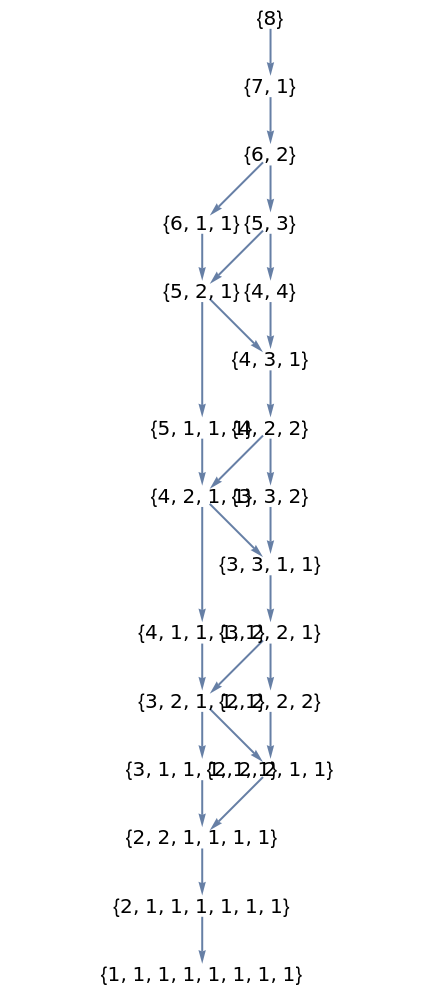Find out if one partition of an integer dominates another
Contributed by:
Wolfram Staff (original content by Sriram V. Pemmaraju and Steven S. Skiena)
Examples
Basic Examples (2)
Since 5+1<4+3, the first partition does not dominate the second:
The first partition dominates the second since 4≥4, 4+4≥4+3 and 4+4≥4+3+1:
Applications (1)
Display the domination lattice on integer partitions, using the resource function HasseDiagram:
Properties and Relations (3)
DominatingIntegerPartitionQ[p,q] being False does not imply that DominatingIntegerPartitionQ[q,p] is True, in this case because the first element of q is smaller than the first element of p:
DominatingIntegerPartitionQ[p,q] and DominatingIntegerPartitionQ[q,p] can both yield True for certain p and q:
Among the partitions of n, {n} is always the largest and {1,…,1} is the smallest:
Related Links
Version History
-
1.0.1
– 31 January 2022
-
1.0.0
– 28 July 2020
Related Resources
![dominationLattice[n_, opts___] := ResourceFunction[
ResourceObject[<|"Name" -> "HasseDiagram", "ShortName" -> "HasseDiagram", "UUID" -> "3836543c-c3fa-422c-99b1-cdeaac2008df", "ResourceType" -> "Function", "Version" -> "1.0.0", "Description" -> "Construct a Hasse diagram of a poset", "RepositoryLocation" -> URL[
"https://www.wolframcloud.com/objects/resourcesystem/api/1.0"], "SymbolName" -> "FunctionRepository`$00e649b9cc5e454c84ad7165f1a59f30`HasseDiagram", "FunctionLocation" -> CloudObject[
"https://www.wolframcloud.com/obj/ff835ddf-f12d-4553-844d-5be7b613b815"]|>, ResourceSystemBase -> Automatic]][ResourceFunction[
"DominatingIntegerPartitionQ"], IntegerPartitions[n], opts, VertexShapeFunction -> "Name"]](https://www.wolframcloud.com/obj/resourcesystem/images/b14/b14809a4-213b-4fae-8a0d-10a9309e2078/1-0-0/71d05023eda518f9.png)
